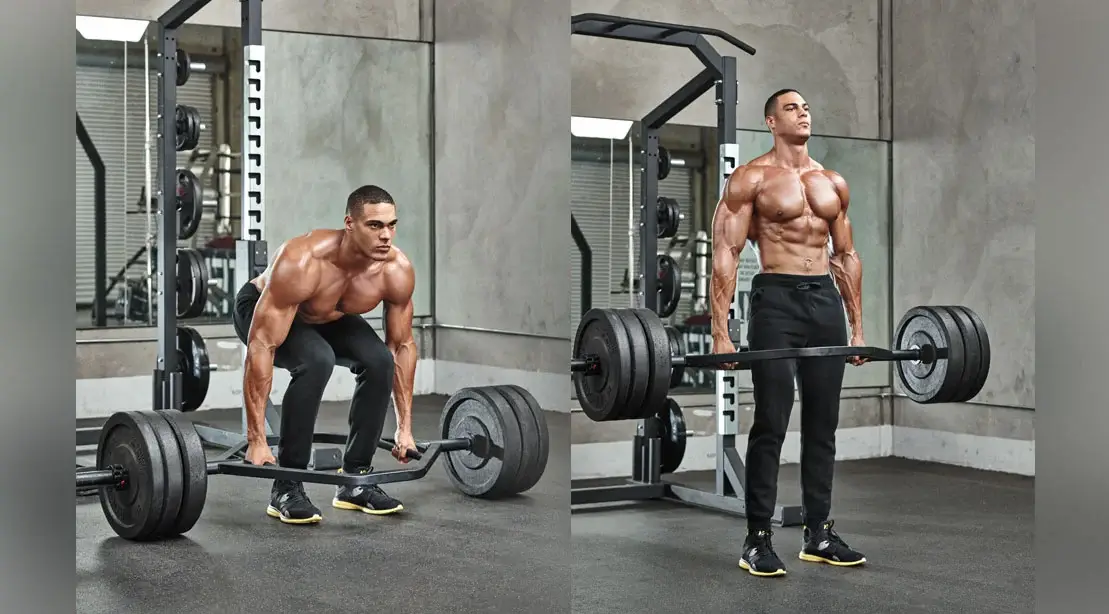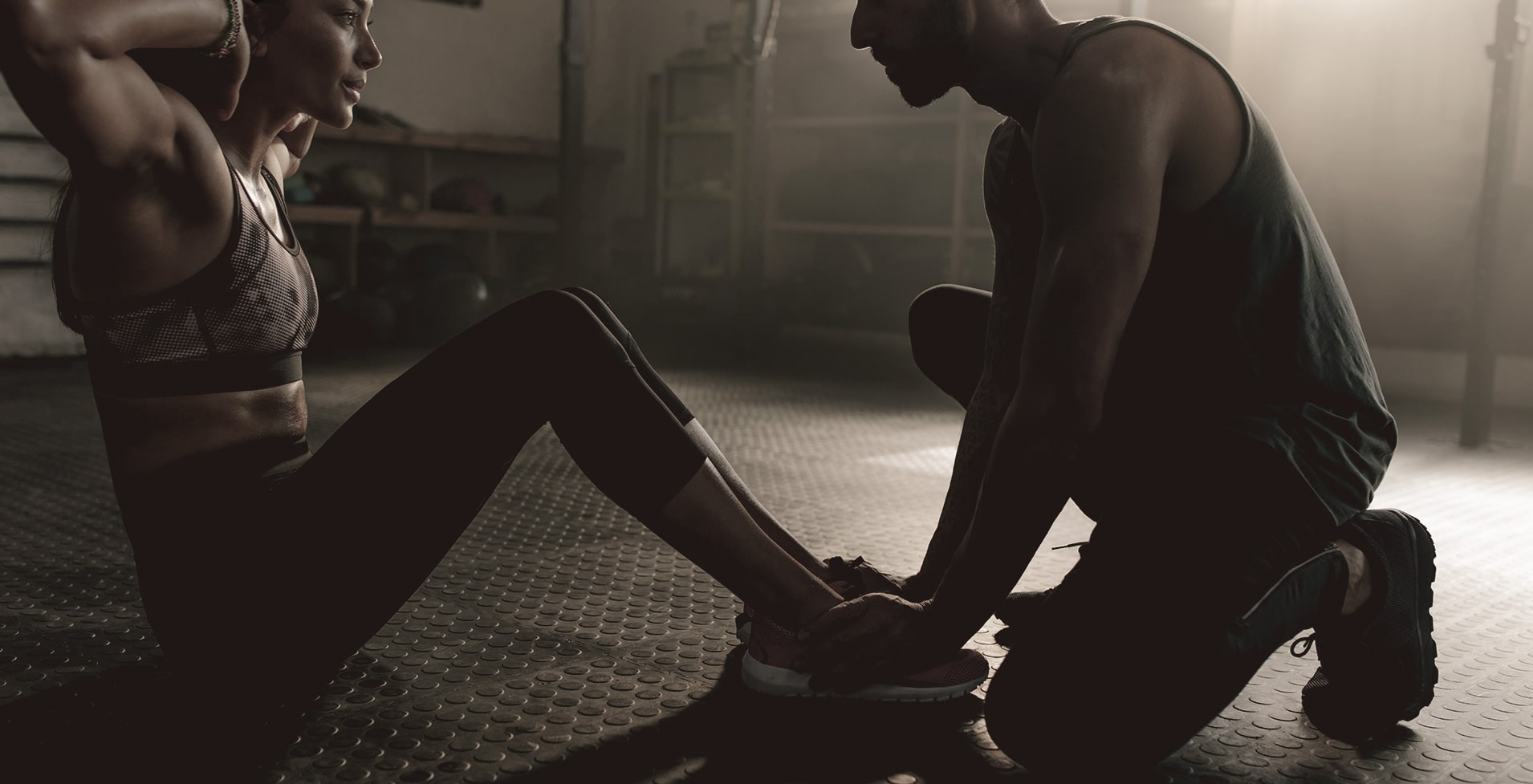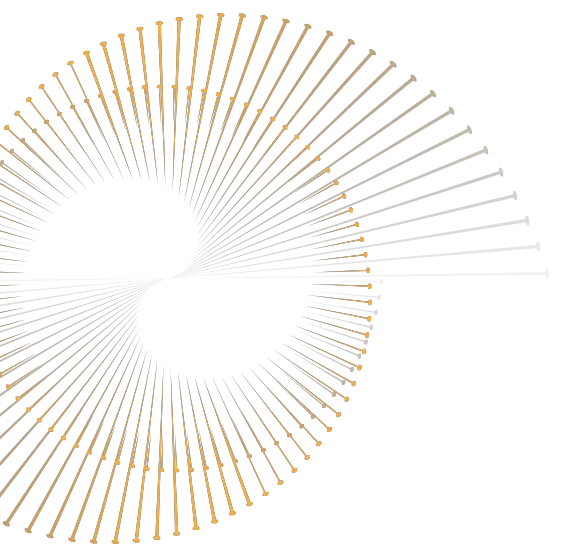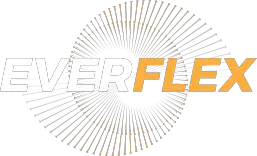Finding a trap bar deadlift alternative for your workout routine can feel overwhelming with the number of exercises out there competing for first place. However, not all exercises are created equal.
To replace hex bar deadlifts, the alternative must incorporate the same muscle groups. In this case, the trap bar deadlift engages the posterior chain muscles, including the glutes and erector spinae. The best alternative will prioritize the same movement pattern and muscle groups so you can achieve your fitness goals whether it be temporarily or long term.
From kettlebell swings to sumo barbell deadlifts, we’ve put together a quality list of the best trap bar deadlift alternatives for you to choose from!
Table of Contents
12 Best Alternatives to Trap Bar Deadlifts
Want a quality trap bar deadlift alternative to add to your workout routine? Then you need to check out these top alternatives we’ve compiled. They incorporate all, if not most, of the same muscle groups, so you can get a quality posterior chain workout!
Conventional Deadlifts

The conventional deadlift is a great alternative to the trap bar deadlift. Regular barbell deadlifts, like the sumo barbell deadlift, incorporate the same muscles throughout the range of motion.
Specifically, the conventional deadlift and the sumo deadlift are the closest alternatives to the trap bar deadlift, hitting the exact muscle groups for hypertrophy and muscle mass goals in the posterior chain.
Benefits
- Compound movement that functions as a great full-body exercise
- Improves torque development and vertical jump performance
- Strengthens the legs, lower back, and core muscles
- Activates the biceps femoris and hip extensors
- Equipment is easy to find in a majority of commercial gyms
Muscles Worked
- Hamstrings
- Gluteal
- Abdominal
- Trapezius
- Erector spinae
- Rhomboids
- Latissimus dorsi
- Adductor Magnus
- Quadriceps
- Calves
How to Perform Conventional Barbell Deadlift
- Move up to the barbell, positioning feet hip-width apart.
- Both feet should be nearly touching the bar.
- Keeping knees slightly bent, use a hip hinge movement to bend to grasp the bar on the outsides of the knees with an overhand grip.
- With the core engaged and back straight, drive the feet into the ground and push the hips forward to return to a standing position.
- Maintain a neutral spine.
- Push the hips back and hinge at the hips to return the bar to the ground.
- This is one repetition.
Sumo Barbell Deadlift

Sumo deadlifts are another great alternative to the trap bar deadlift. Barbell deadlifts, in general, engage the same muscles, like the quads and forearm muscles, as the trap bar deadlift.
The reason for this is that the movement pattern is the same. The “deadlift” prioritizes a hip hinge movement that activates the posterior chain muscles. If you’re looking for a close alternative to the trap bar deadlift, we highly recommend the sumo barbell deadlift!
Benefits
- Full-body compound exercise that activates the posterior chain muscles
- Easier to maintain a straight back when compared to the conventional deadlift
- Requires less range of motion in the hips, perfect for individuals with poor hip mobility
- Great for building muscle mass
- Improves strength
- Less stress on the lower back compared to the traditional deadlift
Muscles Worked
- Quadriceps
- Gluteal
- Adductors Magnus
- Abdominal
- Hamstrings
- Calves
- Erector spinae
How to Perform Sumo Barbell Deadlift
- The starting position for a sumo deadlift begins at the barbell.
- The feet should be placed in a wide stance underneath the bar.
- Maintain a neutral spine with your back flat as you hinge to grasp the bar inside the legs in an overhand grip.
- Brace your core and drive your feet through the ground as you return to a standing position.
- Hinge at the hips with knees slightly bent to return the bar to the ground.
- This is one repetition.
Kettlebell Deadlift

The kettlebell deadlift is perfect for beginners, incorporating hip extension and flexion in the hinge movement pattern. This exercise is the perfect alternative when the gym is too busy and the necessary equipment for the trap bar or barbell deadlift is not available.
As kettlebells come in a broad range of sizes and weights, beginners can easily incorporate the kettlebell deadlift into their routine.
Benefits
- Full-body compound movement
- Improves posture by strengthening the core muscles
- Strengthens the core muscles
- Works to improve grip strength
- Lower risk of injury compared to other deadlift variations
- Enhances overall joint health by improving mobility
Muscles Worked
- Hamstrings
- Gluteal
- Erector spinae
- Forearms
- Adductors
- Quadriceps
- Abdominal
- Trapezius
How to Perform Kettlebell Deadlifts
- Stand with feet shoulder-width apart.
- Bend at the hips, keeping a neutral spine and knees bent slightly, and grasp the kettlebell on the ground.
- Squeeze the shoulder blades in and engage the core muscles.
- Drive the hips forward to return to a standing position.
- Hinge at the hips to lower the kettlebell.
- Depending on the height of the individual performing the kettlebell deadlift or the size of the kettlebell used, the weight may or may not be able to touch the ground in a healthy range of motion during the movement.
- If it does not, the kettlebell does not need to touch the floor.
- Simply stop when the hips have pushed back as far as they will go and return to standing.
Smith Machine Deadlift

The Smith machine deadlift can be used as an alternative to the trap bar deadlift. When the gym is too packed, and equipment is not available for a trap bar deadlift or another alternative, then the Smith machine deadlift is a good choice.
This alternative is great for beginners looking to get started performing the deadlift movement pattern. A conventional or sumo deadlift setup can be used with this equipment. For our instructions on how to perform, we provided step-by-step instructions for the conventional deadlift set up.
Benefits
- Great alternative when there is no equipment to perform a barbell deadlift or when the gym is busy and needed equipment is taken
- Great for beginners
- Compound movement alternative to free weights
Muscles Worked
- Abdominal
- Hamstrings
- Quadriceps
- Calves
- Gluteal
- Erector spinae
- Trapezius
- Rhomboids
- Forearms
How To Perform Smith Machine Deadlift
- To perform this exercise, stand in front of the Smith machine bar with feet shoulder-width apart.
- Feet should be placed underneath the bar, like when performing a conventional or sumo deadlift.
- Grasp the bar overhand at shoulder-width, right outside the thighs.
- Prioritize a neutral spine, drawing the shoulder blades in and engaging the core muscles to lower the bar.
- Once the hips can no longer push back, return to a standing position.
- This is one repetition.
Single-Leg Romanian Deadlifts

The single-leg Romanian deadlift prioritizes the same movement pattern as the Romanian deadlift but with one leg. This means the hip still needs to push back as far as possible before halting and driving through the hips to return to a standing position.
Proper form should not allow the weights to touch the floor. Instead, it should be as far back as the hip can go, pause, and then return to the standing position.
Benefits
- Improves stability and balance
- Increases muscular endurance in the hamstrings
- Full-body functional movement
- Challenges the body’s balance systems with static and dynamic movements
- Activates the posterior chain
Muscles Worked
- Gluteal
- Hamstrings
- Abdominal
- Calves
- Lower back
How to Perform Single-Leg Romanian Deadlift
- Begin in a standing position, holding a dumbbell in both hands.
- Maintain a neutral spine with your core engaged as you hinge forward to lift one leg off the ground.
- Keep the hips forward, preventing the hips from tilting to the sides throughout the movement.
- Drive the leading hip of the foot remaining on the ground as far back as possible as you lower the dumbbells down the legs.
- Once the hips can no longer push back, drive the hips forward to return to a standing position.
- This is one repetition.
Back Extensions

Back extensions are a great addition to workout routines. This exercise can be incorporated as a trap bar deadlift alternative or in the same program.
Using other exercises to promote hypertrophy helps enhance health and fitness results. It is highly recommended in fitness programs to either incorporate more than one exercise or use the same exercise to hit a muscle group repeatedly throughout the training week. The reason for this is that targeting the same muscle groups establishes better efficacy in encouraging muscle growth and desired progress.
Benefits
- Improves range of motion in the lower back
- Corrects poor posture
- Reduced injury risk compared to other exercises like the conventional deadlift
- Low-impact exercise that reduces stress on the joints
- Easy to learn
Muscles Worked
- Erector spinae
- Gluteal
- Hamstrings
- Low back
How to Perform Back Extensions
- Use a back extension machine to perform this exercise. Note that there are variations of these machines, so the setup for the exercise may look different.
- Position feet on the footplate of the machine, resting thighs on the leg pads.
- The pelvis should be just above the top of the pad to prevent obstruction in the range of motion.
- Bend the knees slightly, crossing the arms on the chest or holding a weight plate.
- Taking a deep breath, begin to slowly lean forward to lower the upper body in the direction of the floor.
- After reaching the bottom of the movement, drive the hips forward to return to the starting position.
- This is one repetition.
Rack Pull

The rack pull is frequently used as a means to train to lift heavier loads for deadlifts. It helps improve grip strength and strengthen the body through the upper portion of the deadlift movement pattern.
When looking for an alternative for the trap bar deadlift, the rack pull can act as a replacement that engages the same muscle groups. It is important to note that the rack pull does not incorporate the full range of motion that the trap bar deadlift does, so there will be limitations in progress if seeking hypertrophy.
Benefits
- Improves grip strength
- Reduced injury risk
- Encourages hypertrophy for muscle mass gains
- Used to prepare the body for heavier loads in conventional and sumo deadlifts
Muscles Worked
- Gluteal
- Trapezius
- Forearm
- Quadriceps
- Hamstrings
- Erector spinae
- Latissimus dorsi
How to Perform a Rack Pull
- Set the supports on the rack to an appropriate height at knee height, placing the barbell on the rack.
- Come to a standing position with knees slightly bent and feet hip-width apart at the bar.
- Use an overhand grip to grasp the bar right outside the thighs.
- Tense the abdominal muscles, drawing the shoulder blades in.
- Drive the feet through the floor, pushing the hips forward to lift the bar up to a standing position.
- Push the hips back to rest the barbell back on the rack.
- This is one repetition.
Romanian Deadlift

The Romanian deadlift is one of the best deadlift alternatives. It incorporates a quality range of motion. Mind you, it shouldn’t be a full deadlift range of motion, or it wouldn’t be a Romanian deadlift any longer.
This exercise is very versatile. It can be completed with a barbell, dumbbells, a kettlebell, and so on!
The movement pattern can be confusing for beginners at first. Still, we highly recommend learning this exercise for its benefits in activating the posterior chain and learning the hip hinge movement pattern.
Benefits
- Muscle growth in the hamstrings and glute muscles
- It can be used with a lighter weight like dumbbells, instead of weight plates for beginners looking to practice proper form
- Develops muscular hypertrophy
- Improves deadlift performance by training the same muscles incorporated in the lift
- Supports joint health and performance
- Reduced risk of injury thanks to the exercises’s emphasis on lumbar control
Muscles Worked
- Gluteal
- Hamstring
- Erector spinae
- Adductors
- Abdominal
- Forearms
- Trapezius
How to Perform The Romanian Deadlift
- Get set in the starting position with feet shoulder-width apart and knees slightly bent.
- Grasp the barbell just outside the thighs in an overhand grip.
- Keep arms straight, core engaged, and spine neutral throughout the movement.
- Push the hips to hinge the body forward, keeping the bar as close to the legs as possible.
- Once the hips can no longer push back, pause, then drive the hips forward to return to a standing position.
- This is one repetition.
Kettlebell Swings

The kettlebell swing is a popular exercise in H.I.I.T. and CrossFit workouts for its benefits as a compound exercise. It gets the blood pumping and enhances explosiveness through its quick and controlled hip hinge movement patterns.
Though this exercise does incorporate the same muscle groups as the trap bar deadlift, it isn’t our favorite as a replacement. Instead, we recommend adding this exercise to your program alongside trap bar deadlifts to promote better athleticism in power and explosiveness.
Benefits
- Develops the posterior chain
- Full-body compound exercise
- Enhances power and explosiveness
- Promotes better athletic performance
Muscles Worked
- Hamstrings
- Gluteal
- Rhomboids
- Erector spinae
- Calves
- Trapezius
How to Perform a Kettlebell Swing
- Stand with feet shoulder-width apart and knees slightly bent, grasping the kettlebell in both hands.
- Pull the shoulder blades in, keeping the arms straight and the core engaged to protect the upper body.
- Push the hips back to move the hanging kettlebell in between the legs naturally.
- Drive the hips forward to return to a standing position.
- This is one repetition.
- Immediately flow into the next repetition to perform fluid kettlebell swings, not resting in between each repetition.
Barbell Hip Thrusts

The barbell hip thrust is a must-add to any training program for its outstanding effectiveness in developing the gluteal muscles. The hip thrust can be used with various equipment, including a barbell, kettlebell, dumbbell, and booty bands.
If the trap bar is taken at the gym and you’re looking for an alternative exercise to hit the posterior chain muscles, this is a good exercise. In the long run, we recommend the sumo or conventional barbell deadlift or the Romanian deadlift to switch out with the trap bar deadlift completely. This is because the deadlift is better for strength goals, though we highly suggest keeping the barbell hip thrust in your workout regimen for its overall quality benefits.
Benefits
- Enhances muscular hypertrophy of the gluteus maximus
- Improves short sprint times
- Increases hip mobility
- Boosts strength and power of muscles needed in other compound movements, like the squat and deadlift
Muscles Worked
- Gluteal
- Hamstrings
- Quadriceps
- Erector spinae
How to Perform Barbell Hip Thrusts
- Scooch your back as close as possible to a glute box or low bench.
- Pull the barbell to rest across the upper thighs close to the hips.
- Draw the feet in, placing a bend in the knees.
- Keep the feet flat throughout the barbell hip thrust range of motion.
- Drive through the hips, pushing the bar up to create a straight line with the torso, hips, and knees.
- Ensure the chin remains tucked rather than leaning back to face the ceiling when performing the thrusting movement of this exercise.
- Pause at the top of the movement, squeezing the glutes.
- Slowly return back to the starting position.
- This is one repetition.
Standing Cable Pull Through

The standing cable pull-through is an easily accessible option for anyone looking for an alternative for the trap bar deadlift. It can be simple for beginners to learn and easily accommodated with lighter or heavier weight options.
This exercise incorporates a similar movement pattern to the trap bar deadlift to activate the posterior chain. Overall, we don’t recommend completely replacing a deadlift exercise with the standing cable pull-through. The reason is that lifting heavier weight with the cable makes it more difficult to maintain one’s grip on the attachment. This can affect the quality of form and movement, detracting from progress in the long haul.
Benefits
- Improves hip mobility
- Emphasizes hypertrophy in the hamstrings and gluteal muscles
- Friendly alternative for individuals who suffer from low back pain
- Beginner-friendly
Muscles Worked
- Hamstrings
- Gluteal
- Erector spinae
- Abdominal
How to Perform a Standing Cable Pull Through
- Attach the rope attachment to the cable pulley.
- Set it to the lowest height on the machine.
- Face away from the cable machine, with feet shoulder-width apart.
- Grab the rope attachment in between your legs in a neutral grip, with palms facing each other.
- Take a step forward to create more tension.
- Stand with a slight bend in the knees.
- Maintain a neutral spine throughout the movement, engaging the core and keeping the arms straight.
- Hinge at the hips, stopping when the hips can no longer push back.
- Drive the feet into the floor, pushing the hips forward to return to a standing position.
- This is one repetition.
Bulgarian Split Squat

The Bulgarian split squat is a quality exercise for combatting muscular imbalances in the legs. It promotes hypertrophy, stability, and balance with its one-legged movement pattern.
We don’t recommend replacing trap bar deadlifts with Bulgarian split squats, but switching it up every now and then is completely acceptable. Rather than replace one with the other, we suggest adding the Bulgarian split squat into your routine to upgrade your balance and leg strength.
Benefits
- Prevents possible muscular imbalance concerns
- Improves stability and coordination
- Builds strength
- Encourages hypertrophy
- It can be performed almost anywhere with or without a bench
Muscles Worked
- Quadriceps
- Hamstrings
- Gluteal
- Abdominal
- Adductors
How to Perform a Bulgarian Split Squat
- The starting position for the Bulgarian split squat begins with feet shoulder-width apart and back facing a bench.
- Take a long step with one leg away from the bench.
- Position the other leg on top of the bench.
- Engage the core muscles to maintain stability.
- Drive down into the front foot, pushing the front knee forward and the back knee towards the ground to perform the movement.
- Return to a standing position.
- This is one repetition. Complete the same repetitions on each leg.
Muscles Worked in The Trap Bar Deadlift
Trap bar deadlifts incorporate a range of lower and upper body muscles but, more notoriously, they engage the posterior chain muscles such as the glutes and hamstrings. If you’re looking for a quality alternative to the trap bar deadlift, it should hit all, if not most, of these muscles.
Muscles Worked
- Quadriceps
- Gluteal
- Erector spinae
- Hamstrings
- Trapezius
- Abdominal
Reasons to Choose Trap Bar Deadlift Alternatives
Although trap bar deadlifts make maintaining form easier, there are many deadlift variations that incorporate the same muscles to encourage hypertrophy and strength gains. The range of motion can change with each variation. However, they all should still work the same muscle groups, like the core muscles and posterior chain, and are a quality alternative that reaps the same benefits.
Deadlift alternatives can be extremely helpful when the gym is too packed and equipment is unavailable. It can be frustrating to wait for someone to finish their sets, especially if they take too long and you don’t want to be in the gym forever.
Other reasons may be that you want a more beginner-friendly alternative, or you’re looking to find more exercises that hit the same muscle groups to increase muscle growth and, therefore, muscle mass to hit your fitness goals.
What is The Best Trap Bar Deadlift Alternative?
Picking a deadlift alternative can be challenging, especially since there are so many good options to pick from.
In our humble opinion, we recommend the conventional or sumo barbell deadlift if you’re seeking the best option. Like trap bar deadlifts, these two exercises activate the same muscle groups and empower muscle and strength gains in the same range of motion.
Final Thoughts
Looking for trap bar deadlift alternatives to incorporate into your training program can be challenging. From kettlebell swings to sumo deadlifts, there are so many options to pick from—but what is the best option?
Personally, we think that the sumo or conventional deadlifts are the best options to replace the trap bar deadlifts. They activate the same muscle groups and incorporate the same movement patterns. Next time you hit the gym, try out one or both of these exercises to see which one you like best!














